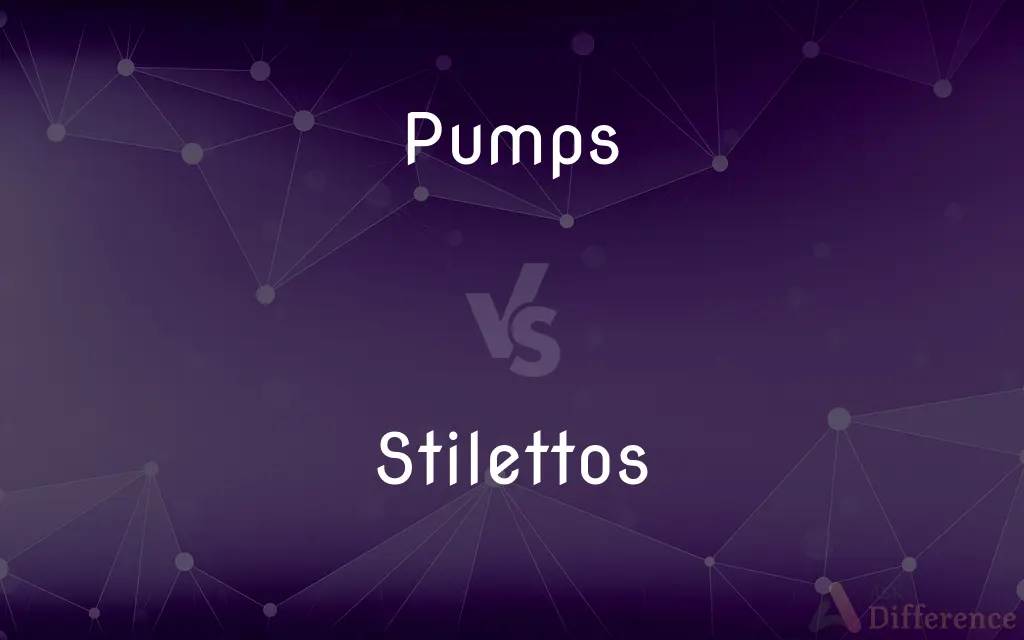Pumps vs. Stilettos — What's the Difference?
By Tayyaba Rehman — Published on December 20, 2023
Pumps are closed-toe shoes with a low-cut front and can have various heel types. Stilettos refer specifically to shoes with a thin and tall heel, often exceeding two inches. While all Stilettos are pumps, not all pumps have stiletto heels.

Difference Between Pumps and Stilettos
Table of Contents
ADVERTISEMENT
Key Differences
Pumps, a staple in many wardrobes, are shoes characterized by their closed-toe design and a low-cut front. Their versatility is notable, as they can complement both formal and casual outfits. While pumps can have varying heel heights and types, they do not specify a particular heel style. Stilettos, on the other hand, are defined by their distinct heel type.
The primary distinguishing feature of Stilettos is their tall, thin heel. Often, these heels exceed two inches, and their slender nature is what sets them apart from other heel types. When someone refers to Stilettos, they're highlighting the heel's elegance and height, not the shoe's overall design. Thus, while Stilettos fall under the category of pumps, they represent a specific subset.
When it comes to comfort and wearability, pumps, in general, offer a broader range. Since pumps can have block heels, kitten heels, or even be flat, they can cater to various comfort levels. Stilettos, with their towering and thin heels, are often considered less comfortable for prolonged wear due to the pressure they place on the ball of the foot.
Both Pumps and Stilettos have earned their place in fashion history. Pumps, with their classic design, have been sported by many throughout the decades, adapting to changing fashion trends. Stilettos, with their dramatic flair, have been synonymous with glamour, sophistication, and sometimes even power, making them a favorite for special occasions and high-fashion events.
Comparison Chart
Definition
Closed-toe shoes with a low-cut front
Shoes with a specific tall and thin heel
ADVERTISEMENT
Heel Variety
Can have various heel types
Always have a thin, tall heel
Typical Heel Height
Varies, can be flat to high
Usually over two inches
Wearability
Ranges from highly comfortable to less so
Often considered less comfortable for long wear
Association
Classic and versatile design
Glamour, sophistication, and drama
Compare with Definitions
Pumps
Pumps can be paired with both formal and casual attire.
Her suede pumps perfectly matched her jeans and blazer.
Stilettos
The heel height for Stilettos often exceeds two inches.
Her red Stilettos added an extra four inches to her height.
Pumps
The heel height of pumps can vary widely.
She opted for flat pumps for daily wear.
Stilettos
Stilettos are shoes with a distinct tall and thin heel.
She wore sparkling Stilettos to the gala.
Pumps
Pumps encompass various heel designs, from block to stiletto.
Her kitten heel pumps were both stylish and comfortable.
Stilettos
Stilettos are considered a symbol of elegance and glamour.
Nothing makes a statement like gold Stilettos.
Pumps
Pumps are closed-toe footwear with a low-cut front.
She wore classic black pumps to the interview.
Stilettos
They can be challenging to walk in due to their height and slimness.
She practiced walking in her Stilettos before the big event.
Pumps
Pumps are timeless, adapting to different fashion eras.
Vintage pumps from the '60s are now back in trend.
Stilettos
Stilettos can elevate the appearance of any outfit.
Her simple dress was transformed with the addition of Stilettos.
Pumps
A machine or device for raising, compressing, or transferring fluids.
Stilettos
A small dagger with a slender, tapering blade.
Pumps
(Physiology)A molecular mechanism for the active transport of ions or molecules across a cell membrane.
Stilettos
Something shaped like such a dagger.
Pumps
(Physics)Electromagnetic radiation used to raise atoms or molecules to a higher energy level.
Stilettos
A small, sharp-pointed instrument used for making eyelet holes in needlework.
Pumps
(Informal)The heart.
Stilettos
A shoe or boot with a stiletto heel.
Pumps
(Informal)The place where consumers purchase gasoline. Used with the:gas prices rising at the pump.
Stilettos
Plural of stiletto
Pumps
A shoe that has a closed back and is cut low around the toes, usually with heels and no fastenings.
Pumps
To cause to flow by means of a pump or pumplike organ or device:Derricks pumped oil out of the ground. The heart pumps blood throughout the body.
Pumps
To draw, deliver, or pour forth:a writer who pumped out a new novel every year.
Pumps
To propel, eject, or insert:pumped new life into the economy.
Pumps
To cause to move with an up-and-down or back-and-forth motion:a bicyclist pumping the pedals; a piston pumping a shaft.
Pumps
To push or pull (a brake or lever, for instance) rapidly:a driver pumping the brakes.
Pumps
To shoot (bullets, for example) at or into:a gunner pumping rounds at a target.
Pumps
(Physics)To raise (atoms or molecules) to a higher energy level by exposing them to electromagnetic radiation at a resonant frequency.
Pumps
(Physiology)To transport (ions or molecules) against a concentration gradient by the expenditure of chemically stored energy.
Pumps
To invest (money) repeatedly or persistently in something.
Pumps
To question closely or persistently:pump a witness for secret information.
Pumps
(Informal)To promote or publicize vigorously:The company pumped its new product on its website.
Pumps
To operate a pump.
Pumps
To move gas or liquid with a pump or a pumplike organ or device.
Pumps
To move up and down or back and forth in a vigorous manner:My legs were pumping as I ran up the stairs.
Pumps
To flow in spurts:Blood was pumping from the wound.
Pumps
(Sports)To fake a throw, pass, or shot by moving the arm or arms without releasing the ball.
Pumps
Plural of pump
Pumps
A low-cut shoe without fastenings
Common Curiosities
How do Stilettos differ from other heels?
Stilettos have a specific tall and thin heel, often exceeding two inches.
Which is more comfortable, pumps or Stilettos?
Generally, pumps offer a broader range of comfort due to varied heel types, whereas Stilettos can be less comfortable for prolonged wear.
What are pumps?
Pumps are closed-toe shoes with a low-cut front and can have various heel types.
Are Stilettos always high-heeled?
Typically, yes. Stilettos are defined by their tall, thin heels.
Are all Stilettos pumps?
Yes, all Stilettos are a type of pump, but not all pumps are Stilettos.
Are all pumps high-heeled?
No, while many pumps have heels, they can also be flat or have low heels.
Can pumps be flat?
Yes, pumps can be flat or have various heel heights.
Are stilettos comfortable to wear?
Due to their high and narrow heel, stilettos can be challenging to walk in and may not be as comfortable as shoes with broader heels. However, some women find them manageable with practice.
When are pumps typically worn?
Pumps can be worn on various occasions, from everyday wear to formal events, depending on their style and material.
When are stilettos typically worn?
Stilettos are often reserved for formal events, parties, or occasions where fashion takes precedence over comfort.
How do pumps differ from ballet flats?
The primary difference is in the heel height. Ballet flats are typically flat-soled, while pumps usually have a heel.
What are stilettos?
Stilettos are shoes characterized by a thin and high heel, typically ranging from 2 to 10 inches.
Why are they called "stilettos"?
The term "stiletto" originally referred to a thin dagger. The shoe's heel resembles the shape of this dagger, leading to the name.
What materials are pumps typically made of?
Pumps can be made from a variety of materials, including leather, suede, fabric, and synthetic materials.
What's the main difference between pumps and stilettos?
While both can be high-heeled shoes, the primary difference lies in the heel type. Pumps have a broader range of heel styles, whereas stilettos are defined by their thin and tall heel.
Share Your Discovery

Previous Comparison
Proximate Analysis vs. Ultimate Analysis
Next Comparison
XML vs. XAMLAuthor Spotlight
Written by
Tayyaba RehmanTayyaba Rehman is a distinguished writer, currently serving as a primary contributor to askdifference.com. As a researcher in semantics and etymology, Tayyaba's passion for the complexity of languages and their distinctions has found a perfect home on the platform. Tayyaba delves into the intricacies of language, distinguishing between commonly confused words and phrases, thereby providing clarity for readers worldwide.
















































